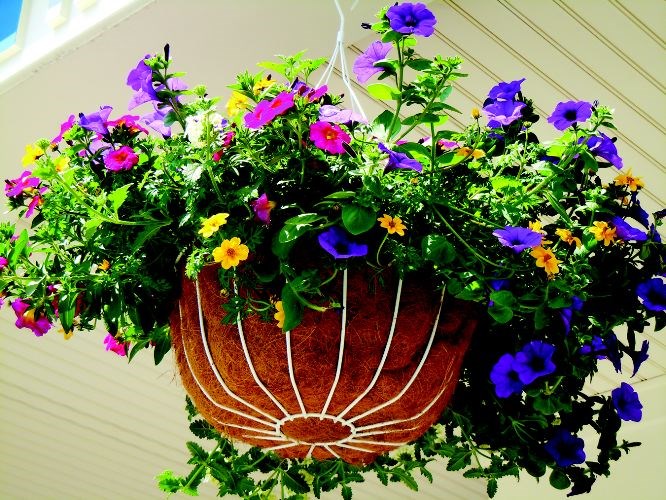Hanging baskets and container gardens are full this time of year and need to be fertilized often and watered daily.
To keep plants healthy and producing flowers they should be fertilized on a weekly basis with a flowering plant fertilizer such as the water soluble 12-36-12.
You may have noticed that containers and hanging baskets are drying out more quickly then they did earlier in the season and this is because the root system is becoming very dense.
Keep up on the watering to prevent plants from drying out and becoming stressed, as it can be hard to bring a plant back after it has been stressed.
If a hanging basket or container becomes too dry it may not absorb the water very well and will need to be rehydrated. You may notice that the soil has pulled away from the edge of the pot/container.
To rehydrate the soil so you will need to water it well, several times in a short span of time (every 30 to 60 minutes) until the soil is completely moistened.
Another method of rehydrating the soil is to place the entire container/hanging basket in a large tub of water and let it soak for a while until the soil is thoroughly moistened.
To prevent fungus, rot or mold, water plants in the morning rather then at night, so that the foliage is dry over night when temperatures are cooler.
It is also important to remove any damaged or dead foliage and stems before they decay which can cause fungus problems.
For the best flower production,
remove all the finished flowers before they form seed, as this takes away important energy from the plant.
If the plants are becoming leggy, trim them back and they will put on new growth and fill out.
Flowerbeds are full of colour right now. Annuals require the same attention as the hanging baskets by watering, fertilizing, and deadheading (removing the
finished flowers).
Perennials that have finished blooming should have the dead flowers removed so that the plants energy goes back to the plant. In some cases, by removing the finished flowers the perennial could produce a second flush of flowers.
On lilies, remove only the finished flowers by breaking or cutting the stem just below the last flower. The remaining stem and foliage is needed for creating energy to grow towards the bulb for next season.
The foliage on spring flowering bulbs such as tulips and daffodils has yellowed and died back by now. If the flowers were smaller this spring then other years it may be time to divide the bulbs.
They should be divided every three to four years because of
overcrowding.
Dig up the bulbs and shake off any excess soil. Place them in a shaded, well-ventilated area for a few days to air dry. When they have dried remove the small bulblets off the larger main bulb.
The small bulblets are tossed out and the large bulb is stored in a cool dry place such as the garage or basement for four to five weeks.
Replant the bulbs in September.
If you choose to save the small bulblets they can be stored and replanted in September. The bulblets are too small to produce a flower for the first two to three years so you may want to plant them in the back somewhere where they will not be on display, and then when the bulb becomes large enough it can be dug up in August, and replanted in September so that it can bloom next spring.



